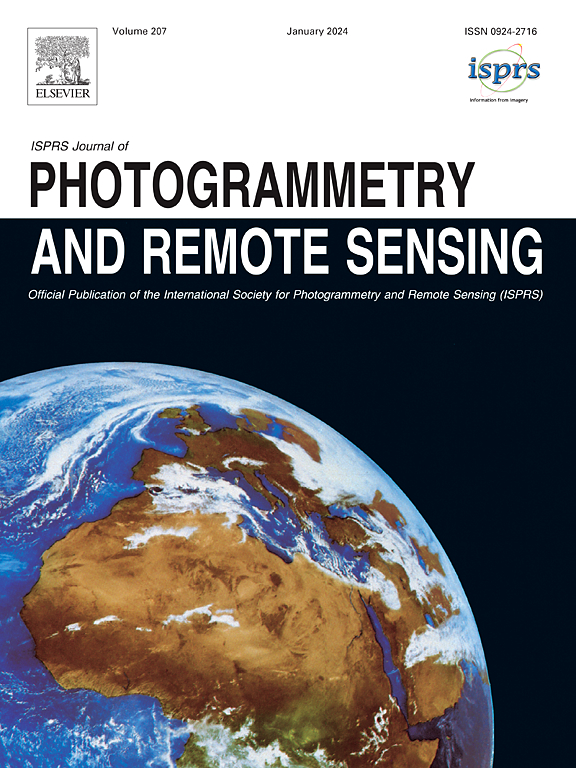Integrating synthetic datasets with CLIP semantic insights for single image localization advancements
IF 10.6
1区 地球科学
Q1 GEOGRAPHY, PHYSICAL
ISPRS Journal of Photogrammetry and Remote Sensing
Pub Date : 2024-11-06
DOI:10.1016/j.isprsjprs.2024.10.027
引用次数: 0
Abstract
Accurate localization of pedestrians and mobile robots is critical for navigation, emergency response, and autonomous driving. Traditional localization methods, such as satellite signals, often prove ineffective in certain environments, and acquiring sufficient positional data can be challenging. Single image localization techniques have been developed to address these issues. However, current deep learning frameworks for single image localization that rely on domain adaptation fail to effectively utilize semantically rich high-level features obtained from large-scale pretraining. This paper introduces a novel framework that leverages the Contrastive Language-Image Pre-training model and prompts to enhance feature extraction and domain adaptation through semantic information. The proposed framework generates an integrated score map from scene-specific prompts to guide feature extraction and employs adversarial components to facilitate domain adaptation. Furthermore, a reslink component is incorporated to mitigate the precision loss in high-level features compared to the original data. Experimental results demonstrate that the use of prompts reduces localization errors by 26.4 % in indoor environments and 24.3 % in outdoor settings. The model achieves localization errors as low as 0.75 m and 8.09 degrees indoors, and 4.56 m and 7.68 degrees outdoors. Analysis of prompts from labeled datasets confirms the model’s capability to effectively interpret scene information. The weights of the integrated score map enhance the model’s transparency, thereby improving interpretability. This study underscores the efficacy of integrating semantic information into image localization tasks.
将合成数据集与 CLIP 语义见解相结合,推动单图像定位技术的发展
行人和移动机器人的精确定位对于导航、应急响应和自动驾驶至关重要。传统的定位方法(如卫星信号)在某些环境下往往无效,而且获取足够的定位数据也具有挑战性。为了解决这些问题,人们开发了单图像定位技术。然而,目前依赖于域自适应的单图像定位深度学习框架未能有效利用从大规模预训练中获得的语义丰富的高级特征。本文介绍了一种新颖的框架,该框架利用对比语言-图像预训练模型和提示,通过语义信息加强特征提取和域适应。所提出的框架从特定场景的提示中生成综合分数图,以指导特征提取,并采用对抗组件来促进领域适应。此外,还加入了重链接组件,以减轻与原始数据相比高级特征的精度损失。实验结果表明,在室内环境中,使用提示可将定位误差降低 26.4%,在室外环境中降低 24.3%。该模型的定位误差在室内可低至 0.75 米和 8.09 度,在室外可低至 4.56 米和 7.68 度。对标注数据集的提示分析证实了该模型有效解释场景信息的能力。综合评分图的权重增强了模型的透明度,从而提高了可解释性。这项研究强调了将语义信息整合到图像定位任务中的功效。
本文章由计算机程序翻译,如有差异,请以英文原文为准。
求助全文
约1分钟内获得全文
求助全文
来源期刊

ISPRS Journal of Photogrammetry and Remote Sensing
工程技术-成像科学与照相技术
CiteScore
21.00
自引率
6.30%
发文量
273
审稿时长
40 days
期刊介绍:
The ISPRS Journal of Photogrammetry and Remote Sensing (P&RS) serves as the official journal of the International Society for Photogrammetry and Remote Sensing (ISPRS). It acts as a platform for scientists and professionals worldwide who are involved in various disciplines that utilize photogrammetry, remote sensing, spatial information systems, computer vision, and related fields. The journal aims to facilitate communication and dissemination of advancements in these disciplines, while also acting as a comprehensive source of reference and archive.
P&RS endeavors to publish high-quality, peer-reviewed research papers that are preferably original and have not been published before. These papers can cover scientific/research, technological development, or application/practical aspects. Additionally, the journal welcomes papers that are based on presentations from ISPRS meetings, as long as they are considered significant contributions to the aforementioned fields.
In particular, P&RS encourages the submission of papers that are of broad scientific interest, showcase innovative applications (especially in emerging fields), have an interdisciplinary focus, discuss topics that have received limited attention in P&RS or related journals, or explore new directions in scientific or professional realms. It is preferred that theoretical papers include practical applications, while papers focusing on systems and applications should include a theoretical background.
 求助内容:
求助内容: 应助结果提醒方式:
应助结果提醒方式:


